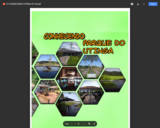3502 Results

Did you ever wonder why you don't need a passport to go from New York to California, but if you were to move from one state to another, you would need a new driver's license? Or why you can use the same currency in all states, but not be subject to the same speed limits? Or why you have to pay both federal and state taxes?
- Subject:
- Political Science
- Social Science
- Material Type:
- Diagram/Illustration
- Provider:
- Independence Hall Association
- Provider Set:
- American Government
- Date Added:
- 02/28/2018

Today many Americans take pride in their status as "independent voters," partly because they see parties as lacking vision for the country. Since many Americans have become disenchanted by partisan politics, they avoid identification as a "loyal Democrat" or a "staunch Republican." These negative attitudes toward parties are rooted in the roles that they play in American politics.
- Subject:
- Political Science
- Social Science
- Material Type:
- Diagram/Illustration
- Provider:
- Independence Hall Association
- Provider Set:
- American Government
- Date Added:
- 02/28/2018

The influence of the media is increased by the fact that campaigns today have become more focused on the individual than on the party. In order to win primaries, individual candidates seek media attention to gain attention from voters. As a result, do voters hold political power, or has the media simply replaced political parties as the primary force behind candidate selection?
- Subject:
- Political Science
- Social Science
- Material Type:
- Diagram/Illustration
- Provider:
- Independence Hall Association
- Provider Set:
- American Government
- Date Added:
- 02/28/2018

What is the difference between a liberty and a right? Both words appear in the Declaration of Independence and the Bill of Rights. The distinction between the two has always been blurred, and today the concepts are often used interchangeably. However, they do refer to different kinds of guaranteed protections.
- Subject:
- Political Science
- Social Science
- Material Type:
- Diagram/Illustration
- Provider:
- Independence Hall Association
- Provider Set:
- American Government
- Date Added:
- 02/28/2018

Charts related to the latest "Consumer Price Index" news release.
- Subject:
- Economics
- Social Science
- Material Type:
- Diagram/Illustration
- Provider:
- Bureau of Labor Statistics
- Date Added:
- 08/21/2023

1492. Columbus. The date and the name provoke many questions related to the linking of very different parts of the world, the Western Hemisphere and the Mediterranean. What was life like in those areas before 1492? What spurred European expansion? How did European, African and American peoples react to each other? What were some of the immediate results of these contacts?
- Subject:
- History
- Material Type:
- Diagram/Illustration
- Reading
- Provider:
- Library of Congress
- Date Added:
- 11/29/2023

An examination of the Manufacturing Industry as a career field.
- Subject:
- Career and Technical Education
- Manufacturing
- Material Type:
- Lecture
- Date Added:
- 09/17/2019

21st Century Workplace Skills is a series of 9 lessons covering the interpersonal, cultural, and digital skills students will need to succeed in career development.
Except where otherwise indicated, 21st Century Workplace Skills by Jennifer McCord at Columbus State Community College is licensed under CC-BY-NC-SA 4.0.
- Subject:
- Business and Communication
- Career and Technical Education
- Material Type:
- Lesson
- Provider:
- Columbus State Community College
- Date Added:
- 07/26/2019

This course is the result of Columbus State Community College's Open Educational Resources Initiative. We started with the goal of creating a comprehensive workplace skills course with no additional student textbook costs. An exhaustive search of the available OER resources determined there was a need for a single collection of materials. Therefore, we have create this series of Workplace Skills lessons for the global community to use, share and adapt, provided the source is acknowledged.
You'll find the Workplace Skills collection of lessons adapted materials from a wide variety of resources including existing OER textbooks, nonprofits, state and national government resources, news outlets and more. Lesson content includes various formats such as readings, articles, videos, podcasts, infographics, activities, worksheets and more. Additional course enhancements created by Columbus State's Distance Education & Instructional Support (DEIS) are also included.
The direct link to Lesson 0 Introduction is https://www.softchalkcloud.com/lesson/serve/Z8t6NMUexXa2F1/html
This course includes the following topics:
Lesson 1 The Future of Work
Lesson 2 Interpersonal Skills
Lesson 3 Decision Making
Lesson 4 Emotional Intelligence
Lesson 5 Working in Teams
Lesson 6 Cultural Competence
Lesson 7 Additional Success Factors
Lesson 8 Digital Literacy
Lesson 9 Career Management
Attributions for each lesson are provided in Lesson 0 on Page 3.
Columbus State Community College Contributors:
Lead Faculty: Jennifer McCord
Open Educational Resources (OER) Librarian: Rachel Dilley
Instructional Designer II: Nancy Stagg
OER Faculty Fellow: Amy Popovich
Peer Reviewer: Dr. Lydia Gilmore
- Subject:
- Business and Communication
- Career and Technical Education
- Material Type:
- Lesson
- Provider:
- Columbus State Community College
- Author:
- Columbus State Community College
- Jennifer McCord
- Date Added:
- 08/06/2019

This course is the result of Columbus State Community College's Open Educational Resources Initiative. We started with the goal of creating a comprehensive workplace skills course with no additional student textbook costs. An exhaustive search of the available OER resources determined there was a need for a single collection of materials. Therefore, we have create this series of Workplace Skills lessons for the global community to use, share and adapt, provided the source is acknowledged.
You'll find the Workplace Skills collection of lessons adapted materials from a wide variety of resources including existing OER textbooks, nonprofits, state and national government resources, news outlets and more. Lesson content includes various formats such as readings, articles, videos, podcasts, infographics, activities, worksheets and more. Additional course enhancements created by Columbus State's Distance Education & Instructional Support (DEIS) are also included.
The direct link to Lesson 1 The Future of Work is https://www.softchalkcloud.com/lesson/serve/bXOSxED9wz5iCN/html
This course includes the following topics:
Lesson 1 The Future of Work
Lesson 2 Interpersonal Skills
Lesson 3 Decision Making
Lesson 4 Emotional Intelligence
Lesson 5 Working in Teams
Lesson 6 Cultural Competence
Lesson 7 Additional Success Factors
Lesson 8 Digital Literacy
Lesson 9 Career Management
Attributions for each lesson are provided in Lesson 0 on Page 3. https://www.softchalkcloud.com/lesson/Z8t6NMUexXa2F1
Columbus State Community College Contributors:
Lead Faculty: Jennifer McCord
Open Educational Resources (OER) Librarian: Rachel Dilley
Instructional Designer II: Nancy Stagg
OER Faculty Fellow: Amy Popovich
Peer Reviewer: Dr. Lydia Gilmore
- Subject:
- Business and Communication
- Career and Technical Education
- Material Type:
- Lesson
- Provider:
- Columbus State Community College
- Author:
- Columbus State Community College
- Jennifer McCord
- Date Added:
- 08/07/2019

This course is the result of Columbus State Community College's Open Educational Resources Initiative. We started with the goal of creating a comprehensive workplace skills course with no additional student textbook costs. An exhaustive search of the available OER resources determined there was a need for a single collection of materials. Therefore, we have create this series of Workplace Skills lessons for the global community to use, share and adapt, provided the source is acknowledged.
You'll find the Workplace Skills collection of lessons adapted materials from a wide variety of resources including existing OER textbooks, nonprofits, state and national government resources, news outlets and more. Lesson content includes various formats such as readings, articles, videos, podcasts, infographics, activities, worksheets and more. Additional course enhancements created by Columbus State's Distance Education & Instructional Support (DEIS) are also included.
The direct link to Lesson 2 Interpersonal Skills is https://www.softchalkcloud.com/lesson/serve/9o7Z2STme4vLRY/html
This course includes the following topics:
Lesson 1 The Future of Work
Lesson 2 Interpersonal Skills
Lesson 3 Decision Making
Lesson 4 Emotional Intelligence
Lesson 5 Working in Teams
Lesson 6 Cultural Competence
Lesson 7 Additional Success Factors
Lesson 8 Digital Literacy
Lesson 9 Career Management
Attributions for each lesson are provided in Lesson 0 on Page 3. https://www.softchalkcloud.com/lesson/Z8t6NMUexXa2F1
Columbus State Community College Contributors:
Lead Faculty: Jennifer McCord
Open Educational Resources (OER) Librarian: Rachel Dilley
Instructional Designer II: Nancy Stagg
OER Faculty Fellow: Amy Popovich
Peer Reviewer: Dr. Lydia Gilmore
- Subject:
- Business and Communication
- Career and Technical Education
- Material Type:
- Lesson
- Provider:
- Columbus State Community College
- Author:
- Columbus State Community College
- Jennifer McCord
- Date Added:
- 08/07/2019

This course is the result of Columbus State Community College's Open Educational Resources Initiative. We started with the goal of creating a comprehensive workplace skills course with no additional student textbook costs. An exhaustive search of the available OER resources determined there was a need for a single collection of materials. Therefore, we have create this series of Workplace Skills lessons for the global community to use, share and adapt, provided the source is acknowledged.
You'll find the Workplace Skills collection of lessons adapted materials from a wide variety of resources including existing OER textbooks, nonprofits, state and national government resources, news outlets and more. Lesson content includes various formats such as readings, articles, videos, podcasts, infographics, activities, worksheets and more. Additional course enhancements created by Columbus State's Distance Education & Instructional Support (DEIS) are also included.
The direct link to Lesson 3 Decision Making is https://www.softchalkcloud.com/lesson/serve/Fb8wLfKUTc1POn/html
This course includes the following topics:
Lesson 1 The Future of Work
Lesson 2 Interpersonal Skills
Lesson 3 Decision Making
Lesson 4 Emotional Intelligence
Lesson 5 Working in Teams
Lesson 6 Cultural Competence
Lesson 7 Additional Success Factors
Lesson 8 Digital Literacy
Lesson 9 Career Management
Attributions for each lesson are provided in Lesson 0 on Page 3. https://www.softchalkcloud.com/lesson/Z8t6NMUexXa2F1
Columbus State Community College Contributors:
Lead Faculty: Jennifer McCord
Open Educational Resources (OER) Librarian: Rachel Dilley
Instructional Designer II: Nancy Stagg
OER Faculty Fellow: Amy Popovich
Peer Reviewer: Dr. Lydia Gilmore
- Subject:
- Business and Communication
- Career and Technical Education
- Material Type:
- Lesson
- Provider:
- Columbus State Community College
- Author:
- Columbus State Community College
- Jennifer McCord
- Date Added:
- 08/07/2019

This course is the result of Columbus State Community College's Open Educational Resources Initiative. We started with the goal of creating a comprehensive workplace skills course with no additional student textbook costs. An exhaustive search of the available OER resources determined there was a need for a single collection of materials. Therefore, we have create this series of Workplace Skills lessons for the global community to use, share and adapt, provided the source is acknowledged.
You'll find the Workplace Skills collection of lessons adapted materials from a wide variety of resources including existing OER textbooks, nonprofits, state and national government resources, news outlets and more. Lesson content includes various formats such as readings, articles, videos, podcasts, infographics, activities, worksheets and more. Additional course enhancements created by Columbus State's Distance Education & Instructional Support (DEIS) are also included.
The direct link to Lesson 4 Emotional Intelligence is https://www.softchalkcloud.com/lesson/serve/Ytr3oVKTz1Bb4U/html
This course includes the following topics:
Lesson 1 The Future of Work
Lesson 2 Interpersonal Skills
Lesson 3 Decision Making
Lesson 4 Emotional Intelligence
Lesson 5 Working in Teams
Lesson 6 Cultural Competence
Lesson 7 Additional Success Factors
Lesson 8 Digital Literacy
Lesson 9 Career Management
Attributions for each lesson are provided in Lesson 0 on Page 3. https://www.softchalkcloud.com/lesson/Z8t6NMUexXa2F1
Columbus State Community College Contributors:
Lead Faculty: Jennifer McCord
Open Educational Resources (OER) Librarian: Rachel Dilley
Instructional Designer II: Nancy Stagg
OER Faculty Fellow: Amy Popovich
Peer Reviewer: Dr. Lydia Gilmore
- Subject:
- Business and Communication
- Career and Technical Education
- Material Type:
- Lesson
- Provider:
- Columbus State Community College
- Author:
- Columbus State Community College
- Jennifer McCord
- Date Added:
- 08/07/2019

This course is the result of Columbus State Community College's Open Educational Resources Initiative. We started with the goal of creating a comprehensive workplace skills course with no additional student textbook costs. An exhaustive search of the available OER resources determined there was a need for a single collection of materials. Therefore, we have create this series of Workplace Skills lessons for the global community to use, share and adapt, provided the source is acknowledged.
You'll find the Workplace Skills collection of lessons adapted materials from a wide variety of resources including existing OER textbooks, nonprofits, state and national government resources, news outlets and more. Lesson content includes various formats such as readings, articles, videos, podcasts, infographics, activities, worksheets and more. Additional course enhancements created by Columbus State's Distance Education & Instructional Support (DEIS) are also included.
The direct link to Lesson 5 Working in Teams is https://www.softchalkcloud.com/lesson/serve/AHuYr4yd1RwvxE/html
This course includes the following topics:
Lesson 1 The Future of Work
Lesson 2 Interpersonal Skills
Lesson 3 Decision Making
Lesson 4 Emotional Intelligence
Lesson 5 Working in Teams
Lesson 6 Cultural Competence
Lesson 7 Additional Success Factors
Lesson 8 Digital Literacy
Lesson 9 Career Management
Attributions for each lesson are provided in Lesson 0 on Page 3. https://www.softchalkcloud.com/lesson/Z8t6NMUexXa2F1
Columbus State Community College Contributors:
Lead Faculty: Jennifer McCord
Open Educational Resources (OER) Librarian: Rachel Dilley
Instructional Designer II: Nancy Stagg
OER Faculty Fellow: Amy Popovich
Peer Reviewer: Dr. Lydia Gilmore
- Subject:
- Business and Communication
- Career and Technical Education
- Material Type:
- Lesson
- Provider:
- Columbus State Community College
- Author:
- Columbus State Community College
- Jennifer McCord
- Date Added:
- 08/07/2019

This course is the result of Columbus State Community College's Open Educational Resources Initiative. We started with the goal of creating a comprehensive workplace skills course with no additional student textbook costs. An exhaustive search of the available OER resources determined there was a need for a single collection of materials. Therefore, we have create this series of Workplace Skills lessons for the global community to use, share and adapt, provided the source is acknowledged.
You'll find the Workplace Skills collection of lessons adapted materials from a wide variety of resources including existing OER textbooks, nonprofits, state and national government resources, news outlets and more. Lesson content includes various formats such as readings, articles, videos, podcasts, infographics, activities, worksheets and more. Additional course enhancements created by Columbus State's Distance Education & Instructional Support (DEIS) are also included.
The direct link to Lesson 6 Cultural Competency is https://www.softchalkcloud.com/lesson/serve/VzEjXxdUIB65up/html
This course includes the following topics:
Lesson 1 The Future of Work
Lesson 2 Interpersonal Skills
Lesson 3 Decision Making
Lesson 4 Emotional Intelligence
Lesson 5 Working in Teams
Lesson 6 Cultural Competence
Lesson 7 Additional Success Factors
Lesson 8 Digital Literacy
Lesson 9 Career Management
Attributions for each lesson are provided in Lesson 0 on Page 3. https://www.softchalkcloud.com/lesson/Z8t6NMUexXa2F1
Columbus State Community College Contributors:
Lead Faculty: Jennifer McCord
Open Educational Resources (OER) Librarian: Rachel Dilley
Instructional Designer II: Nancy Stagg
OER Faculty Fellow: Amy Popovich
Peer Reviewer: Dr. Lydia Gilmore
- Subject:
- Business and Communication
- Career and Technical Education
- Material Type:
- Lesson
- Provider:
- Columbus State Community College
- Author:
- Columbus State Community College
- Jennifer McCord
- Date Added:
- 08/07/2019

This course is the result of Columbus State Community College's Open Educational Resources Initiative. We started with the goal of creating a comprehensive workplace skills course with no additional student textbook costs. An exhaustive search of the available OER resources determined there was a need for a single collection of materials. Therefore, we have create this series of Workplace Skills lessons for the global community to use, share and adapt, provided the source is acknowledged.
You'll find the Workplace Skills collection of lessons adapted materials from a wide variety of resources including existing OER textbooks, nonprofits, state and national government resources, news outlets and more. Lesson content includes various formats such as readings, articles, videos, podcasts, infographics, activities, worksheets and more. Additional course enhancements created by Columbus State's Distance Education & Instructional Support (DEIS) are also included.
The direct link to Lesson 7 Additional Success Factors is https://www.softchalkcloud.com/lesson/serve/54Wu6zEO2y1HMi/html
This course includes the following topics:
Lesson 1 The Future of Work
Lesson 2 Interpersonal Skills
Lesson 3 Decision Making
Lesson 4 Emotional Intelligence
Lesson 5 Working in Teams
Lesson 6 Cultural Competence
Lesson 7 Additional Success Factors
Lesson 8 Digital Literacy
Lesson 9 Career Management
Attributions for each lesson are provided in Lesson 0 on Page 3. https://www.softchalkcloud.com/lesson/Z8t6NMUexXa2F1
Columbus State Community College Contributors:
Lead Faculty: Jennifer McCord
Open Educational Resources (OER) Librarian: Rachel Dilley
Instructional Designer II: Nancy Stagg
OER Faculty Fellow: Amy Popovich
Peer Reviewer: Dr. Lydia Gilmore
- Subject:
- Business and Communication
- Career and Technical Education
- Material Type:
- Lesson
- Provider:
- Columbus State Community College
- Author:
- Columbus State Community College
- Jennifer McCord
- Date Added:
- 08/07/2019

This course is the result of Columbus State Community College's Open Educational Resources Initiative. We started with the goal of creating a comprehensive workplace skills course with no additional student textbook costs. An exhaustive search of the available OER resources determined there was a need for a single collection of materials. Therefore, we have create this series of Workplace Skills lessons for the global community to use, share and adapt, provided the source is acknowledged.
You'll find the Workplace Skills collection of lessons adapted materials from a wide variety of resources including existing OER textbooks, nonprofits, state and national government resources, news outlets and more. Lesson content includes various formats such as readings, articles, videos, podcasts, infographics, activities, worksheets and more. Additional course enhancements created by Columbus State's Distance Education & Instructional Support (DEIS) are also included.
The direct link to Lesson 8 Digital Literacy is https://www.softchalkcloud.com/lesson/serve/cUj72bWkfEVd3C/html
This course includes the following topics:
Lesson 1 The Future of Work
Lesson 2 Interpersonal Skills
Lesson 3 Decision Making
Lesson 4 Emotional Intelligence
Lesson 5 Working in Teams
Lesson 6 Cultural Competence
Lesson 7 Additional Success Factors
Lesson 8 Digital Literacy
Lesson 9 Career Management
Attributions for each lesson are provided in Lesson 0 on Page 3. https://www.softchalkcloud.com/lesson/Z8t6NMUexXa2F1
Columbus State Community College Contributors:
Lead Faculty: Jennifer McCord
Open Educational Resources (OER) Librarian: Rachel Dilley
Instructional Designer II: Nancy Stagg
OER Faculty Fellow: Amy Popovich
Peer Reviewer: Dr. Lydia Gilmore
- Subject:
- Business and Communication
- Career and Technical Education
- Material Type:
- Lesson
- Provider:
- Columbus State Community College
- Author:
- Columbus State Community College
- Jennifer McCord
- Date Added:
- 08/07/2019

This course is the result of Columbus State Community College's Open Educational Resources Initiative. We started with the goal of creating a comprehensive workplace skills course with no additional student textbook costs. An exhaustive search of the available OER resources determined there was a need for a single collection of materials. Therefore, we have create this series of Workplace Skills lessons for the global community to use, share and adapt, provided the source is acknowledged.
You'll find the Workplace Skills collection of lessons adapted materials from a wide variety of resources including existing OER textbooks, nonprofits, state and national government resources, news outlets and more. Lesson content includes various formats such as readings, articles, videos, podcasts, infographics, activities, worksheets and more. Additional course enhancements created by Columbus State's Distance Education & Instructional Support (DEIS) are also included.
The direct link to Lesson 9 Career Management is https://www.softchalkcloud.com/lesson/serve/iOXcjzW6vyF9hH/html
This course includes the following topics:
Lesson 1 The Future of Work
Lesson 2 Interpersonal Skills
Lesson 3 Decision Making
Lesson 4 Emotional Intelligence
Lesson 5 Working in Teams
Lesson 6 Cultural Competence
Lesson 7 Additional Success Factors
Lesson 8 Digital Literacy
Lesson 9 Career Management
Attributions for each lesson are provided in Lesson 0 on Page 3. https://www.softchalkcloud.com/lesson/Z8t6NMUexXa2F1
Columbus State Community College Contributors:
Lead Faculty: Jennifer McCord
Open Educational Resources (OER) Librarian: Rachel Dilley
Instructional Designer II: Nancy Stagg
OER Faculty Fellow: Amy Popovich
Peer Reviewer: Dr. Lydia Gilmore
- Subject:
- Business and Communication
- Career and Technical Education
- Material Type:
- Lesson
- Provider:
- Columbus State Community College
- Author:
- Columbus State Community College
- Jennifer McCord
- Date Added:
- 08/07/2019

Powerful KINGDOMS, beautiful sculpture, complex trade, tremendous wealth, centers for advanced learning — all are hallmarks of African civilization on the eve of the age of exploration.
- Subject:
- History
- U.S. History
- Material Type:
- Lesson
- Provider:
- Independence Hall Association
- Date Added:
- 08/22/2023
